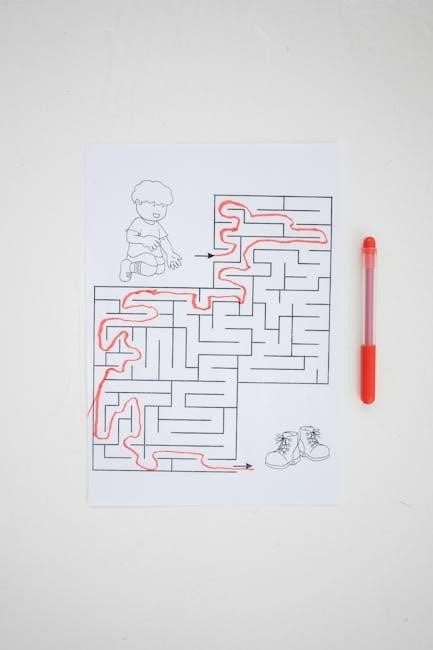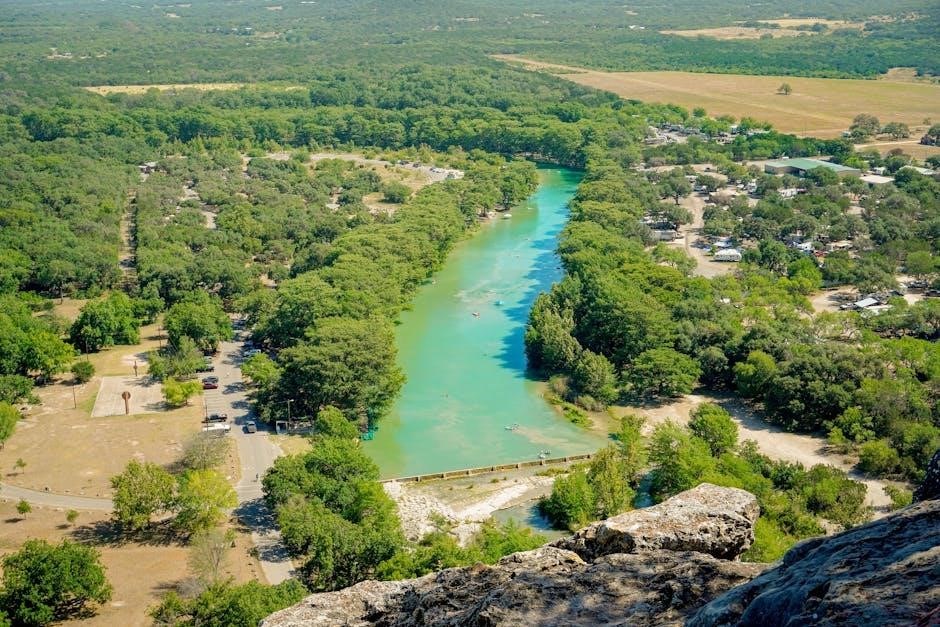The water cycle is a fundamental natural process, and a printable worksheet is an excellent tool for teaching and understanding its stages. This resource simplifies complex concepts into an easy-to-follow format, making it ideal for educational settings. Whether for classroom use or homeschooling, a well-designed water cycle worksheet provides a visually appealing and logically structured way to explore this essential topic, fostering an interactive and engaging learning experience.
1.1 What is the Water Cycle?
The water cycle, also known as the hydrologic cycle, is the continuous process by which water is circulated between the Earth and the atmosphere. It involves the movement of water in three phases: liquid, vapor, and ice. The cycle includes evaporation, condensation, precipitation, and collection. Evaporation occurs when water from oceans, lakes, and rivers turns into vapor. Condensation happens when water vapor cools and forms clouds. Precipitation occurs when water falls back to Earth as rain, snow, or hail. Finally, collection happens as water gathers on the surface or recharges groundwater. Understanding the water cycle is crucial for grasping Earth’s climate, weather patterns, and the availability of freshwater resources. It is a vital concept in science education, particularly for students learning about environmental systems and conservation.
1.2 Importance of the Water Cycle in Education
Teaching the water cycle in educational settings is essential for building foundational knowledge in science. It helps students understand Earth’s systems, climate, and the importance of water conservation. By studying the water cycle, students gain insights into how weather patterns form and how water resources are distributed. This concept also fosters critical thinking and problem-solving skills, as students explore the impacts of environmental changes. Incorporating the water cycle into curricula prepares students to address real-world challenges, such as water scarcity and climate change. Engaging educational tools, like printable worksheets, make learning interactive and memorable, ensuring that students develop a strong grasp of this vital scientific process.

Benefits of Using a Printable Water Cycle Worksheet
A printable water cycle worksheet offers numerous educational benefits, including enhanced engagement, improved retention, and structured learning. It provides a hands-on approach to understanding the water cycle, making complex concepts accessible and fun for students. The worksheet also serves as a valuable assessment tool, allowing educators to gauge students’ comprehension effectively. Its portability and ease of use make it a versatile resource for both classroom and individual learning environments.

2.1 Enhanced Student Engagement
A printable water cycle worksheet significantly enhances student engagement by providing an interactive and visually appealing learning experience. The structured format allows learners to actively participate in understanding the water cycle’s processes through diagrams, labels, and short-answer questions. This hands-on approach makes abstract concepts more tangible and relatable, encouraging students to explore and interact with the material. Additionally, the use of colorful visuals and clear instructions captures students’ attention, making the lesson more dynamic and enjoyable. By incorporating elements that cater to different learning styles, the worksheet ensures that all students, regardless of their preferences, remain focused and involved in the learning process. This engagement fosters a deeper connection to the subject matter and promotes active participation in classroom discussions.
2.2 Reinforces Learning Concepts
A printable water cycle worksheet plays a crucial role in reinforcing learning concepts by providing students with a structured and organized way to review and practice the material. The worksheet offers a hands-on approach, allowing learners to engage with key concepts such as evaporation, condensation, and precipitation through interactive activities like labeling diagrams, matching terms, and answering questions. This repetition and practical application of knowledge help solidify understanding and improve retention. Additionally, the worksheet’s visual elements, such as illustrations and flowcharts, provide a clear and concise representation of the water cycle, making it easier for students to grasp and remember complex processes. By revisiting the material in a focused manner, students are better equipped to apply their knowledge in future lessons and assessments.
2.4 Facilitates Assessment
A printable water cycle worksheet serves as an effective tool for assessing students’ understanding of the topic. By incorporating multiple-choice questions, short-answer sections, and opportunities for diagram labeling, the worksheet allows educators to evaluate students’ knowledge retention and comprehension. The structured format makes it easy to identify gaps in learning and track progress over time. Additionally, the worksheet provides a clear and objective way to assess students’ ability to apply concepts, such as identifying the stages of the water cycle or explaining key processes. This feature is particularly useful for teachers looking to gauge student mastery before moving on to more advanced topics, ensuring a solid foundation for future learning.
Key Components of an Effective Worksheet
An effective worksheet should include clear instructions, engaging visuals, and structured activities to promote understanding and retention of the water cycle concept. Clarity and conciseness are essential to ensure students focus on learning rather than deciphering complex instructions. Incorporating diagrams, charts, and interactive elements enhances comprehension and makes the material more accessible. Additionally, the worksheet should align with curriculum standards to ensure relevance and provide opportunities for critical thinking and creativity. By combining these elements, a well-designed worksheet creates a solid foundation for learning and reinforces key concepts in an organized and engaging manner.
3.1 Clear Diagrams and Illustrations
Clear diagrams and illustrations are essential for helping students visualize and understand the water cycle process. Visual representations, such as labeled diagrams of evaporation, condensation, and precipitation, simplify complex concepts. High-quality images ensure accuracy and engagement, while colorful illustrations capture students’ attention and make learning fun. These visuals also cater to different learning styles, particularly benefiting visual learners. Additionally, diagrams can include interactive elements, such as fill-in-the-blank labels or matching activities, to reinforce learning. Properly designed visuals eliminate confusion and provide a clear framework for understanding the water cycle’s continuous process. By integrating these elements, worksheets become more effective educational tools, enhancing both comprehension and retention for students of all ages.
3.2 Interactive Elements for Better Understanding

Interactive elements in a water cycle worksheet, such as fill-in-the-blank exercises, matching games, and sequencing activities, make learning engaging and dynamic. These features encourage students to actively participate, fostering a deeper understanding of key concepts like evaporation, condensation, and precipitation. By allowing students to manipulate and organize information, these elements help reinforce their grasp of the water cycle’s continuous process. Interactive components also provide immediate feedback, enabling students to identify and correct misunderstandings. This hands-on approach not only enhances retention but also makes the learning experience more enjoyable, catering to a variety of learning styles and promoting active involvement in the educational process.

Design Tips for Creating Engaging Worksheets
A well-designed worksheet engages students by balancing clear instructions with visual elements, ensuring a logical flow and easy navigation to enhance learning effectively.
4.1 Layout and Readability
A well-organized layout is crucial for a printable water cycle worksheet. Ensure the design is clean, with adequate white space to avoid overwhelming students. Use a clear, readable font in a consistent size throughout the worksheet. Align text and visuals properly to maintain a professional appearance. Incorporate bullet points or numbered lists for step-by-step explanations, making complex concepts easier to digest. Avoid clutter by separating different sections visually, such as using borders or shaded areas. Proper spacing between questions and diagrams allows students to focus without confusion. Clear headings and subheadings help guide students through the material, enhancing overall comprehension and engagement.
4.2 Use of Visual Aids
Visual aids are essential for making a water cycle worksheet engaging and effective. Incorporate high-quality diagrams, images, and infographics to help students visualize the process. Use labeled illustrations to depict the stages of the water cycle, such as evaporation, condensation, and precipitation. Include side-by-side comparisons of processes like transpiration and runoff to clarify differences. Color-coded elements can highlight key components, making the worksheet more interactive and visually appealing. Ensure visuals are relevant and complement the text, avoiding clutter. Clear and concise captions for images will guide students in understanding the content. By integrating visual aids effectively, the worksheet becomes a powerful tool for enhancing comprehension and retention of the water cycle concept.

4.3 Age-Appropriate Design
Age-appropriate design is crucial for ensuring the effectiveness of a water cycle worksheet. For younger students, use simple language, bold headings, and large, colorful visuals to maintain their interest. Older students benefit from more detailed diagrams and technical terms, aligning with their advanced understanding. Tailor the content to match the curriculum level, ensuring it challenges without overwhelming. Use a clean, organized layout that appeals to the target age group. For example, elementary worksheets might include fun illustrations, while high school versions could incorporate more scientific imagery. By designing the worksheet to suit the age and skill level of the students, you create a more engaging and effective learning tool.

Finding the Right Printable Worksheet
Finding the right printable water cycle worksheet involves identifying resources that align with your educational goals and audience. Start by searching trusted educational websites or databases using keywords like “water cycle worksheet PDF” or “printable water cycle diagram.” Ensure the worksheet is age-appropriate, visually appealing, and comprehensive in covering key concepts. Check for customization options to tailor the content to your specific needs. Additionally, review the worksheet for clarity and accuracy to guarantee it effectively communicates the water cycle process. A well-designed worksheet not only enhances learning but also saves time, making it a valuable resource for educators and students alike.
5.1 Free Resources Available Online

There are numerous free printable water cycle worksheet resources available online, offering a variety of formats and designs. Websites like Teachers Pay Teachers, Education.com, and NASA’s educational resources provide high-quality, downloadable PDFs that cater to different grade levels and learning needs. These worksheets often include diagrams, labeling exercises, and short-answer questions to engage students. Searching for keywords such as “free water cycle worksheet PDF” or “printable water cycle activity” can help locate these resources quickly. While free options are cost-effective and convenient, they may include advertisements or limited customization. However, they remain a valuable starting point for educators seeking to introduce or reinforce water cycle concepts in the classroom.
5.2 Paid Resources for Detailed Content
Paid resources for printable water cycle worksheets offer more detailed and comprehensive content compared to free options. These premium materials often include advanced diagrams, in-depth explanations, and interactive elements designed to enhance learning. Platforms like Teachers Pay Teachers and educational marketplaces provide access to professionally designed worksheets tailored for specific grade levels or learning objectives. Paid resources may also include additional features such as answer keys, teaching guides, and multimedia components. While they require a small investment, they are ideal for educators seeking high-quality, customizable materials to support their curriculum. These resources are particularly useful for teachers who need structured, detailed content to ensure a thorough understanding of the water cycle process.
5.3 Tips for Selecting the Best Worksheet
When choosing a printable water cycle worksheet, consider its alignment with your curriculum and learning objectives. Ensure the content is accurate, age-appropriate, and visually appealing. Prioritize worksheets with clear diagrams and concise explanations to aid understanding. Check for interactive elements, such as labeling exercises or short-answer questions, to encourage student engagement. Additionally, verify that the worksheet is easy to print and distribute. For digital use, ensure compatibility with your classroom technology. Finally, read reviews or previews to confirm the worksheet meets your needs. By selecting a well-designed and relevant resource, you can maximize its educational value and effectiveness for your students.

Using the Worksheet in the Classroom
A printable water cycle worksheet enhances engagement by assigning students to label diagrams or complete short-answer questions. It guides them through complex concepts, promoting active learning and retention. Teachers can use it to track progress and provide feedback, ensuring students grasp the material effectively. The worksheet serves as a versatile tool for interactive and structured learning experiences.
Introducing the water cycle concept is essential for students to understand Earth’s hydrologic processes. A printable worksheet serves as a visual guide, outlining evaporation, condensation, and precipitation. It simplifies complex processes, making them accessible for all learning levels. The worksheet can include diagrams, labels, and short explanations to engage students. Teachers can use it to introduce the topic, ensuring a strong foundation for further exploration. Interactive elements like fill-in-the-blanks or matching games enhance comprehension and retention. This structured approach helps students connect theoretical knowledge with practical application, fostering a deeper understanding of the water cycle’s role in our environment.
6.2 Distributing and Assigning the Worksheet
Distributing the water cycle worksheet ensures all students have access to the material. Teachers can print copies or share digital versions, depending on classroom resources. Clear instructions should accompany the worksheet to guide students. Demonstrate complex concepts visually to aid understanding. Encourage students to review the worksheet independently before starting. This structured approach helps maintain focus and ensures the activity runs smoothly. Assigning the worksheet as homework or in-class work allows teachers to monitor progress effectively. Providing additional support for struggling students ensures inclusivity and equal learning opportunities. This step is crucial for maximizing engagement and ensuring all students benefit from the exercise.
6.3 Encouraging Group Discussion
Group discussions are an effective way to deepen students’ understanding of the water cycle. After distributing the worksheet, encourage students to work in pairs or small groups to compare answers and share insights. This collaborative approach fosters critical thinking and teamwork. Teachers can pose open-ended questions related to the worksheet to stimulate dialogue, such as asking students to explain their understanding of evaporation or condensation. Group discussions also allow peers to teach and learn from one another, reinforcing concepts. By actively participating, students develop communication skills and gain confidence in expressing their ideas. This interactive method ensures that learning is dynamic and engaging, making the water cycle concept more relatable and memorable for all students;
6.4 Reviewing and Providing Feedback
After students complete the worksheet, reviewing their work and providing feedback is crucial for reinforcing learning. Teachers should go through each section, ensuring students understand key concepts like evaporation, condensation, and precipitation. Immediate feedback helps clarify any misunderstandings and strengthens retention. Highlighting both correct and incorrect answers encourages students to reflect on their learning. For example, if a student mislabels a diagram, explain the correct process using simple examples. Positive reinforcement for accurate answers boosts confidence, while constructive criticism guides improvement. Individualized feedback also helps tailor instruction to meet specific needs. By reviewing the worksheet collectively or in one-on-one sessions, educators can address common misconceptions and ensure all students grasp the water cycle effectively.
Extending Learning Beyond the Worksheet

Extend learning by incorporating hands-on activities, such as water cycle simulations or field trips, to deepen understanding. Encourage students to explore real-world applications of the water cycle, fostering a connection between classroom concepts and environmental science.
7.1 Suggested Follow-Up Activities
To further engage students, consider implementing interactive simulations that allow them to model the water cycle digitally. Organize a water cycle journaling activity where students observe and record local water cycle phenomena over a week. Additionally, setting up a classroom hydrology project enables hands-on exploration of water movement and storage. These activities not only reinforce concepts but also encourage critical thinking and real-world application of water cycle principles.
7.2 Additional Resources for Deeper Understanding
To enhance learning, incorporate educational videos that visually explain the water cycle process. Interactive websites with simulations can provide hands-on exploration. Additionally, recommend books or e-books that delve into the science behind the water cycle. Encourage students to explore real-world applications, such as studying local water systems or climate patterns. Field trips to museums or environmental centers can also deepen understanding. Finally, suggest online courses or workshops for advanced learners to explore water cycle-related topics in greater detail. These resources create a well-rounded learning experience that complements the worksheet and fosters a deeper appreciation for Earth’s hydrological processes.
A printable water cycle worksheet is a valuable educational tool that simplifies the complex process of the water cycle into an engaging and accessible format. By incorporating visual aids, interactive elements, and clear instructions, these worksheets make learning fun and effective for students of all ages. They not only enhance understanding but also encourage critical thinking and retention of key concepts. Educators can leverage these resources to create a comprehensive learning experience that fosters curiosity and appreciation for environmental science. Whether used in classrooms or at home, a well-designed water cycle worksheet is an indispensable asset for teaching this essential topic. Its versatility and adaptability make it a timeless tool for education.
